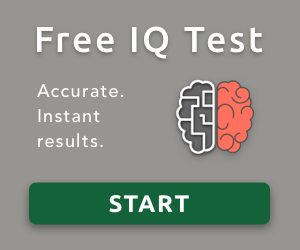What is intelligence?
Despite the century-old development of Intelligence theory in Psychology, there seems to be no consensus on what exactly is intelligence (e.g. Sternberg & Kaufman, 2011, Hampshire et al, 2012). Broadly speaking, intelligence is a person’s “general mental capability” (Gottfredson, 1997, pp.13), involving abstract reasoning, problem-solving, quick learning from experience, etc. We tend to associate intelligence with people who more than having a bookish knowledge of the world, are able to “make sense” of things, “figuring out” what to do, and “catching on” to something (Gottfredson, 1997).
The idea that one single entity would be in the origin of all the elements included in the construct of intelligence came from the fact that there is a certain stability in the performance of seemingly unrelated cognitive tasks (Spearman, 1904), an early finding that has proven robust over the years (Kovacs & Conway, 2019). Spearman (1904) proposed that a dominant general factor or G would be the cause for the strong correlations between results in different intelligence tests.
Because intelligence is such an abstract and multidimensional construct, assessing it directly is impossible. Thus intelligence assessment tests use the behavior of individuals (e.g. their performance in certain cognitive tasks) to infer their level of intelligence (Kranzler & Floyd, 2013; Kovacs & Conway, 2019). The IQ (Intelligence Coefficient) level is, therefore, a computation of the results of tests assessing different cognitive abilities believed to reflect the general factor G.
Over the years, there have been a myriad of models of intelligence that are linked to multiple tests of intelligence, like the Wechsler Adult Intelligence Scale, the Stanford-Binet Scale or Raven Progressive Matrices (Daniel, 1997). Although there is little consensus on the best way to define and assess intelligence, three constructs are prevalent in the literature as central elements of intelligence: deductive and inductive reasoning and memory (especially working memory).
Our approach for assessing IQ focuses on these three elements:
- Deductive reasoning - a cognitive mechanism or process required in order to solve predefined problems with known rules and models (Cosmides & Tooby, 2002; Johnson-Laird, 1999).
- Inductive reasoning – also known as “improvisational intelligence” refers to the ability to improvise solutions to novel problems (Cosmides & Tooby, 2002) with contingencies that may or may not repeat themselves in other circumstances.
- Working memory - the brain's capacity to retain information to be used within a short period of time to support logical reasoning and/or decision-making processes (Miyake & Shah, 1999; Malenka, Nestler & Hyman, 2009)
Regardless of all controversies, IQ is strongly related – more so than any other single human variable thus far identified in the scientific literature – to many important educational, occupational, economic, and social outcomes; whatever IQ tests assess, it seems to be of undeniable practical and social significance (Gottfredson, 1997).
About the author
Helena Martins is a Researcher and Professor in the area of Human Resources Management. She has trained in the field of Psychology as well as Management and currently lectures in Lisbon, Portugal. Her research and teaching interests are the development of soft skills for crisis and change situations where solid psychological assessment is key as a starting point for efficacious interventions.
ORCID / Research Gate / Ciência Vitae
References:
Cosmides, L., and Tooby, J. (2002). Unraveling the enigma of human intelligence: evolutionary psychology and the multimodular mind. in R. J. Sternberg and J. C. Kaufman(Eds) The Evolution of Intelligence, 145–198. Mahwah, NJ: Erlbaum.
Daniel, M. (1997). Intelligence Testing: status and trends. American Psychologist. 52(10), 1038-1045.
Gottfredson, L. S. (1997). Mainstream science on intelligence: an editorial with 52 signatories, history, and bibliography (Reprinted from The Wall Street Journal, 1994). Intelligence 24, 13–23. doi: 10.1016/S0160-2896(97)90011-8.
Johnson-Laird, P. (1999). Deductive reasoning. Annual Review of Psychology, 50, 109-135.
Kovacs, K. & Conway, A. (2019). What is IQ: life beyond “general intelligence”. Current Directions in Psychological Science. 28(2), 184-194.
Kranzler, J. H., & Floyd, R. G. (2013). Assessing intelligence in children and adolescents: A practical guide. Guilford Press.
Malenka RC, Nestler EJ, Hyman SE (2009). "Chapter 13: Higher Cognitive Function and Behavioral Control". In Sydor A, Brown RY (eds.). Molecular Neuropharmacology: A Foundation for Clinical Neuroscience (2nd ed.). New York: McGraw-Hill Medical. pp. 313–321. ISBN 978-0-07-148127-4.
Miyake, A.; Shah, P., eds. (1999). Models of working memory. Mechanisms of active maintenance and executive control. Cambridge University Press. ISBN 0-521-58325-X.
Spearman, C. (1904). ‘‘General intelligence’’ objectively determined and measured. Am. J. Psychol. 15, 201–293.
Sternberg, R. J., & Kaufman, S. B. (Eds.). (2011). The Cambridge handbook of intelligence. Cambridge University Press.

